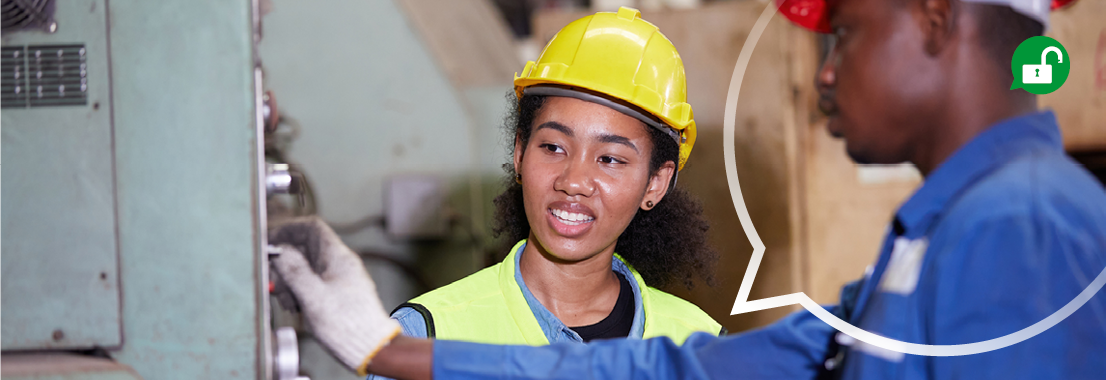
Apprentices: Building the future of health and safety
Apprentices: Building the future of health and safety
Jane Warren looks at the huge benefits that health and safety apprentices can bring to organisations.
When politics graduate Alfie Gatenby applied for an apprenticeship with Wales & West Utilities last year, he expected to be assigned to an engineering division at the gas network. Instead, he was offered an apprenticeship with the Process Safety and Assurance (PSA) team.
"Safety is the top priority for Wales & West Utilities and this became clear to me as I've navigated my way around the business and seen the operational work first hand" says Alfie, 21. “I’m really enjoying it and I can already see that health and safety opens up my options in ways I didn’t expect.”
 Alfie Gatenby
Alfie Gatenby
Shortly after joining in September, Alfie was taken by his mentor, Martin Cook, Head of Health and Safety at the utility company, to carry out a risk analysis on one of the most hazardous high-pressure sites on the network.
“I found it interesting that all these highly trained experts came together from around the business to work together,” enthuses Alfie.
“I was impressed by the level of competence, and the way the health and safety team coordinated everyone.”
The value of apprenticeships is once again being showcased through National Apprenticeship Week (NAW) 2024 from February 5-11. Run by the Government apprenticeships scheme, this year’s event has the theme ‘Skills for Life’. It hopes to encourage individuals to consider how apprenticeships can help develop the expertise required for a rewarding career, and employers to develop a workforce with future-ready skills.
As for health and safety in particular, apprenticeships could be an answer to the growing skills gap being left by retiring H&S professionals - as well as offering the opportunity for more diversity and inclusion in recruitment.
Rhianna Sexton, Assistant Editor at SHP and IFSEC Insider, an online health and safety newsletter for security and fire professionals, says there is a “chasm” being left by retirement which is failing to be filled by a new cohort in the health and safety industry.
“Discussions continue about how to make health and safety an attractive career for young people,” says Rhianna.
“Both issues could be solved by established health and safety professionals mentoring apprentices.”
Apprenticeships in England are available to anyone over the age of 16 and take between one and six years to complete. They are paid jobs which incorporate on and off the job training.
Apprentices have the same rights as other employees and are entitled to be paid at least the apprentice rate of the national minimum wage. As of September 2022, more than 800 different apprenticeships were available and more than 700,000 people participated in an apprenticeship in the 2022-2023 academic year (52 per cent were aged under 25). The Government hopes to grow this figure significantly over the coming years.
New insights
Martin Cook at Wales & West Utilities finds apprentices to be a breath of fresh air and believes they will shape the future of the profession.
“I’ve worked with apprentices in other businesses and last year I said I’d like an apprentice in my health and safety team here,” he says.
“Apprenticeships assist in succession planning.”
He says they also invigorate businesses with new insights. “Apprentices see things differently and their ideas aren’t tarnished by what happened in the past. They bring a fresh awareness of the world and of life.”
One example of this is fatigue management. Martin says: “This is a hot topic in our industry at the moment and is relative to life outside work. Different generations have different commitments, leisure and social activities that need to be considered when measuring fatigue. An apprentice can bring insight into what is feeding those aspects within their own age group. That’s a valuable alternative perspective.”
Having the chance to contribute to the conversation is Martin’s apprentice, Alfie Gatenby: “One of the most satisfying aspects of my apprenticeship role is being able to tell other people in the business about the health and safety legislation and how it has changed, and finding ways to explain, demystify and interpret it.
“There is a lot of legislation, and it is an area that can be changed as well as interpreted differently by different people,” says Alfie who says his politics degree has given him a suite of transferable skills.
He adds: “I would encourage graduates and non-graduates to look into apprenticeships. It’s really valuable gaining qualifications while getting experience and being paid.”
His mentor Martin Cook would also like to see more young people consider health and safety as a career.
“Universities, colleges and industry need to get closer around this, to help develop with industry some form of career pathway from leaving school to becoming head of health and safety. I don’t think that career pathway is as well established as in other areas, and I’d like to see it on the radar,” says Martin who says he is proud of the fact that his 35-year-long career has no doubt saved lives.
“We need to let younger generations know that this is a rewarding and meaningful career that requires a high level of empathy and communication: After all, you are working to convince people to do the right thing even when it might take longer.
“Like all other skilled professions in industry, we are going to suffer a skills shortage in the future unless we attract talent.”
Safety of young workers
The safety of all apprentices is, of course, a consideration for employers, whatever their industry. Young people are particularly vulnerable to hazards in the workplace with a 40 per cent higher rate of non-fatal injuries among those aged 18-24 than older workers in all sectors. This is despite evidence that younger employees are more likely than their older colleagues to actually read health and safety guidance.
Every apprentice should feel safe and happy in their working environment and should never be asked to carry out an activity without proper training. Apprentices should be told about potential dangers in the workplace and instructed how to complete potentially hazardous tasks and supervised appropriately.
In January 2013, a 16-year-old engineering apprentice, Cameron Minshull, tragically lost his life after becoming entangled in a lathe. Prosecutors alleged that his employer used apprentices as “cheap labour”, had a history of failing to train them properly and a “grossly” unsafe system of work.
As an example of best practice, younger employees and apprentices at Wales & West Utilities are given a young person’s risk assessment within a few days of joining.
“This is carried out collaboratively with the individual to identify specific hazards they may face, and the controls for those hazards,” says Martin Cook. They are also more closely supervised due to their different perception of risk.
However, getting apprentices involved in health and safety culture starts from day one.
“We engage with them from the moment they come into the office for interview when safety is considered and communicated. We show empathy for their wellbeing and demonstrate its importance. We demand safety always.
“It is so rewarding being the mentor of an apprentice. You see them start their career and watch them progress. If you are prepared to put the time and effort in there is nothing more rewarding than watching somebody flourish.”
Home-grown skills
Nuclear engineering firm Jacobs used to go to the market to fill vacancies until they realised they needed to grow their own talent.
“We canvassed colleges that were offering health and safety qualifications and identified Lakes College in Cumbria,” says Eddie McGrath, HSE Director at Jacobs. Two candidates stood out and were taken on to the company’s HSE apprentice programme in September 2022.
“Both our apprentices have active project roles supporting our work at Sellafield in Cumbria, which is the largest nuclear complex in Western Europe, so there’s plenty to keep them busy and interested. We didn’t want to bring in apprentices to spend a lot of time sitting at a desk. It was important to me to get them out onto the job, see it in action, and have the opportunity to be involved.”
Jacobs follow a 70-20-10 model for career development where 70 is on the job experience, 20 per cent is coaching and mentoring, and 10 per cent is academic.
“Our health and safety apprentices come with no bias or opinion on old practices, and modern technology is second nature to them, so they easily adapt to the digital solutions we have,” says Eddie, who encourages any young person considering health and safety as a career option to discount the views of people who may have a negative perception of the industry.
“Go and speak to the people who are working in it – people stay in this career for a long time and that tells a story in itself,” he says.
“Career opportunities, progression, development, challenge – it’s all there in health and safety and I wish I’d joined the industry sooner.”
Jane Warren is a highly experienced freelance journalist, feature writer and non-fiction author. She has written for the Daily Express newspaper for over thirty years.
Already a member? Login to MyRoSPA to read more articles

Login to you MyRoSPA account
Login to MyRoSPA to view more exclusive content
Login
| Join RoSPA
Become a member now
Become a member to access MyRoSPA to view more exclusive content
Join
Already a member? Login to MyRoSPA to read more articles

Login to you MyRoSPA account
Login to MyRoSPA to view some more exclusive content
Login
| Join RoSPA
Become a member now
Become a part of the MyRoSPA team to view more exclusive content
Register